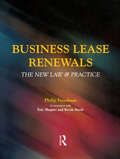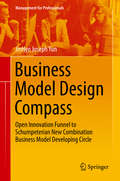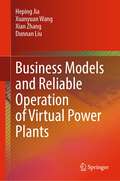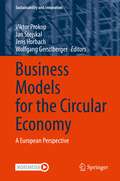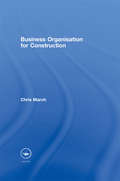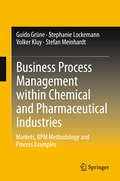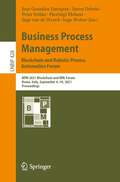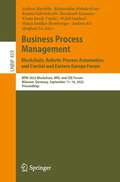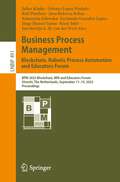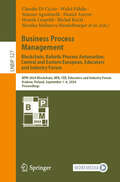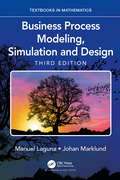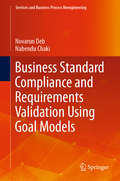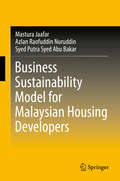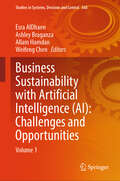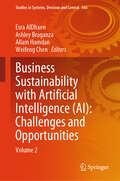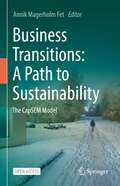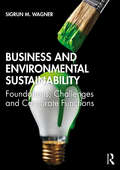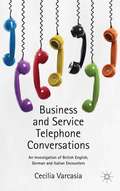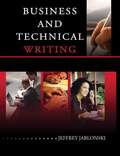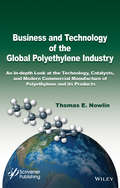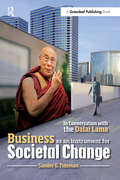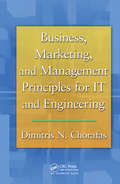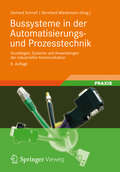- Table View
- List View
Business Lease Renewals
by Eric Shapiro Philip Freedman Kevin SteeleEvery surveyor, property manager and lawyer who deals with commercial property needs to have a thorough knowledge of Part II of the Landlord and Tenant Act 1954, which governs the rights of business tenants to obtain renewals of their leases. A maze of complex and carefully interlocking provisions, the Act was radically amended by a Regulatory Reform Order as from 1 June 2004.These changes include:•widening the scope of protection•removing traps for tenants such as the counter-notice•changing the rules about court applications•amending the basis of assessing interim rent•imposing tougher requirements for giving information•creating new procedures for contracting out of the Act•a raft of new prescribed formsThis new book gives a clear explanation of the workings of the amended Act, keeping the framework in view while delving into the detail whenever needed. The old law is included for those situations where it may still be relevant. Written by a property lawyer assisted by a chartered surveyor and a property litigator, this publication, in addition to setting out the law, gives detailed guidance on practice for surveyors, managers, valuers, expert witnesses and property lawyers.
Business Model Design Compass: Open Innovation Funnel to Schumpeterian New Combination Business Model Developing Circle (Management for Professionals)
by Jinhyo Joseph YunThis book reveals how open innovation utilizes the developing circle of business models to establish new ones that define a unique link between technology and markets, focusing on how to develop and maintain successful business models. It draws readers into the philosophy and economic effects of open innovation from the outset. It presents four different developing circle business models for customers in the role of consumers, entrepreneurs, social entrepreneurs and engineers respectively, enabling each group to develop, utilize and enlarge creative business models, and even switch business models. In addition to these four circles, it takes a systemic approach to describe the relationship between technology and markets. From this relationship an open innovation strategy towards entrepreneurship can be adopted. From Open Innovation to a Creative Developing-Circle Business Model is an essential resource for start-up entrepreneurs, as well as for students of technology management, strategy and open innovation.
Business Models and Reliable Operation of Virtual Power Plants
by Xian Zhang Heping Jia Xuanyuan Wang Dunnan LiuThis book focuses on the business operation of virtual power plants. Both of the business models and reliable operation of virtual power plants have been addressed with engineering practices. This is achieved by providing an in-depth study on several major topics such as load forecasting for distributed energy resources, business model and practice of virtual power plants, the business operation of virtual power plants participating in demand response, and auxiliary service market. The dynamic pricing strategy of virtual power plants and reliable operation of power systems with virtual power plants are provided as well. The comprehensive and systematic treatment in business operation of virtual power plants is one of the major features of the book, which is particularly suited for readers who are interested to learn operation mechanisms of virtual power plants. The book benefits researchers, engineers, and graduate students in the fields of energy internet, electrical engineering, and business administration, etc.
Business Models for Renewable Energy in the Built Environment
by Iea-RetdBusiness Models for Renewable Energy in the Built Environment provides insight to policy makers and market actors as to the ways that new and innovative business models (and/or policy measures) can stimulate the deployment of renewable energy technologies (RET) and energy efficiency (EE) measures in this field. This project was initiated and funded by the IEA Implementing Agreement for Renewable Energy Technology Deployment (IEA-RETD). It analyses ten business models in three categories, covering different types of energy service companies (ESCO’s). Included developing properties certified with a ‘green’ building label building owners profiting from rent increases after EE measures property Assessed Clean Energy (PACE) financing on-bill financing leasing of RET equipment. Coverage extends to the organisational and financial structure of the models and the existing market and policy context, plus analysis of Strengths, Weaknesses, Opportunities and Threats (SWOT). The book concludes with recommendations for policy makers and other market actors on how to encourage and accelerate built environment renewable energy technologies.
Business Models for the Circular Economy: A European Perspective (Sustainability and Innovation)
by Jan Stejskal Jens Horbach Wolfgang Gerstlberger Viktor ProkopIncreased ecological awareness and the growing scarcity of resources have led to the introduction of new environmental standards, triggering enterprises, regions, and even countries to adopt new business models and industrial reconversion approaches. However, despite increased interest in business models and their innovation, it still lacks the integration of circularity and sustainability and to date research on these areas is still limited. This book, therefore, provides readers with a closer picture of the issues of business models and their innovation for the circular economy in Europe, where the issues of sustainability and the shift towards the circular economy have become cornerstones of European policies and documents and where significant differences have been identified between firms and countries. This book provides a unique view of different European perspectives and enables the reader to compare the situation in countries with completely different historical and economic conditions as well as with different perceptions of the need for the actions leading to the sustainable development and to the shift towards the circular economy.
Business Organisation for Construction
by Chris MarchWith a user-friendly style and a strong theoretical base, Business Organisation for Construction provides readers with the tools required to skillfully and successfully operate a business in today's construction industry. Arranged into three sections, Chris March explains: strategy and vision, business finance and the market place the organization, recruitment, support, motivation and leadership of people communication and negotiation. With a wealth of practical construction industry experience, March provides rich anecdotal evidence to enlighten the theory, as well as illustrations and tables to clarify. Available singly or as part of a set, Business Organisation for Construction is a valuable resource for construction students.
Business Process Management within Chemical and Pharmaceutical Industries: Markets, BPM Methodology and Process Examples
by Guido Grüne Stephanie Lockemann Volker Kluy Stefan MeinhardtAs business processes are crucial success factors for companies, software-based Business Process Management (BPM) is becoming more and more important. In this area SAP, the market leader for enterprise application software, has already gathered substantial experience. For the characterization, modeling and especially the optimization of business processes, SAP's consultants use their own BPM approach. In addition to their considerable methodological know-how, the consultants' profound knowledge of the industries facilitates the focus on core and business-critical processes. This book examines the current market situation, as well as the specific challenges and trends for the chemical and pharmaceutical industries. It also explains business process management basics and the specific SAP Consulting methodology, before illustrating the use of such methods and procedures with sample industry-specific core business processes. With the help of these examples from the chemical and pharmaceutical industries, SAP Consulting provides methodological guidelines on how Business Process Management can be used in practice to optimize business processes and make adjustments in response to constantly changing economic and environmental factors.
Business Process Management: BPM 2021 Blockchain and RPA Forum, Rome, Italy, September 6–10, 2021, Proceedings (Lecture Notes in Business Information Processing #428)
by Ingo Weber Pierluigi Plebani José González Enríquez Søren Debois Peter Fettke Inge van de WeerdThis book constitutes the proceedings of the Blockchain and RPA Forum, held as part of the 19th International Conference on Business Process Management, BPM 2021, which took place during September 6-10, 2021, in Rome, Italy.The Blockchain Forum and the RPA Forum have in common that they are centered around an emerging and exciting technology. The blockchain is a sophisticated distributed ledger technology, while RPA software allows for mimicking human, repetitive actions. Each of these have the potential to fundamentally change how business processes are being orchestrated and executed in practice. The 8 papers presented in this volume were carefully reviewed and selected from a total of 14 submissions.
Business Process Management: BPM 2022 Blockchain, RPA, and CEE Forum, Münster, Germany, September 11–16, 2022, Proceedings (Lecture Notes in Business Information Processing #459)
by Andrea Kő Walid Gaaloul Raimundas Matulevičius Renata Gabryelczyk Mojca Indihar Štemberger Andrea Marrella Bernhard Axmann Vesna Bosilj Vukšić Qinghua LuThis book constitutes the proceedings of the Blockchain, Robotic Process Management (RPA), and Central and Eastern Europe (CEE) Forum which were held as part of the 20th International Conference on Business Process Management, BPM 2022, which took place in Münster, Germany, during September 11-15, 2022. The Blockchain Forum is dealing with techniques for and applications of blockchains, distributed ledger technologies, and related topics. "The RPA Forum brings together researchers from various communities to discuss challenges, opportunities, and new ideas related to robotic process automation and its application to business processes in private and public sectors." The CEE Forum provides a discussion platform for BPM academics from Central and Eastern Europe to disseminate their research, compare results and share experiences. The 20 papers presented in this volume were carefully reviewed and selected from a total of 40 submissions.
Business Process Management: BPM 2023 Blockchain, RPA and Educators Forum, Utrecht, The Netherlands, September 11–15, 2023, Proceedings (Lecture Notes in Business Information Processing #491)
by Ralf Plattfaut Jorge Munoz-Gama Julius Köpke Orlenys López-Pintado Jana-Rebecca Rehse Katarzyna Gdowska Fernanda Gonzalez-Lopez Koen Smit Jan Martijn E. M. van der WerfThis book constitutes the proceedings of the BPM Forum held at the 21st International Conference on Business Process Management, BPM 2023, which took place in Utrecht, The Netherlands, in September 2023. The Blockchain Forum provided a platform for exploring and discussing innovative ideas on the intersection of BPM and blockchain technology. The RPA Forum focused on the use of the Robotic Process Automation (RPA) in the field of Business Process Management. The Educators Forum brought together educators within the BPM community for sharing resources to improve the practice of teaching BPM-related topics. The 18 full papers included in this volume were carefully reviewed and selected from a total of 39 submissions.
Business Process Management: BPM 2024 Blockchain, RPA, CEE, Educators and Industry Forum, Krakow, Poland, September 1–6, 2024, Proceedings (Lecture Notes in Business Information Processing #527)
by Ralf Plattfaut Claudio Di Ciccio Renata Gabryelczyk Daniel Amyot Henrik Leopold Thomas Grisold Katarzyna Gdowska Monika Malinova Mandelburger Simone Agostinelli Walid Fdhila Michal Krčál Gregor Polančič Katarina Tomičić-Pupek Piotr Sliż Iris BeerepootThis book constitutes the proceedings of the BPM 2024 Blockchain/RPA/CEE/Educators/Industry Forum held at the 22nd International Conference on Business Process Management, BPM 2024, which took place in Krakow, Poland, in September 2024. The Blockchain Forum provided a platform for exploring and discussing innovative ideas on the intersection of BPM and blockchain technology. The CEE Forum deals with BPM research in Central and Eastern European countries, emphasizing the specific challenges due to cultural, political, regional, or organizational differences. The RPA Forum focused on the use of the Robotic Process Automation (RPA) in the field of Business Process Management. The Educators Forum brought together educators within the BPM community for sharing resources to improve the practice of teaching BPM-related topics. The Industry Forum served as a platform connecting academia and industry professionals to exchange real-world experiences and insights on leveraging Business Process Management. The total of 35 papers included in this book was carefully reviewed and selected from a total of 69 papers submitted to these forums.
Business Process Modeling, Simulation and Design (Textbooks in Mathematics)
by Manuel Laguna Johan MarklundBusiness Process Modeling, Simulation and Design, Third Edition provides students with a comprehensive coverage of a range of analytical tools used to model, analyze, understand, and ultimately design business processes. The new edition of this very successful textbook includes a wide range of approaches such as graphical flowcharting tools, cycle time and capacity analyses, queuing models, discrete-event simulation, simulation-optimization, and data mining for process analytics. While most textbooks on business process management either focus on the intricacies of computer simulation or managerial aspects of business processes, this textbook does both. It presents the tools to design business processes and management techniques on operating them efficiently. The book focuses on the use of discrete event simulation as the main tool for analyzing, modeling, and designing effective business processes. The integration of graphic user-friendly simulation software enables a systematic approach to create optimal designs.
Business Standard Compliance and Requirements Validation Using Goal Models (Services and Business Process Reengineering)
by Nabendu Chaki Novarun DebThis book discusses enterprise hierarchies, which view a target system with varying degrees of abstraction. These requirement refinement hierarchies can be represented by goal models. It is important to verify that such hierarchies capture the same set of rationales and intentions and are in mutual agreement with the requirements of the system being designed. The book also explores how hierarchies manifest themselves in the real world by undertaking a data mining exercise and observing the interactions within an enterprise. The inherent sequence-agnostic property of goal models prevents requirement analysts from performing compliance checks in this phase as compliance rules are generally embedded with temporal information. The studies discussed here seek to extract finite state models corresponding to goal models with the help of model transformation. The i*ToNuSMV tool implements one such algorithm to perform model checking on i* models. In turn, the AFSR framework provides a new goal model nomenclature that associates semantics with individual goals. It also provides a reconciliation machinery that detects entailment or consistency conflicts within goal models and suggests corrective measures to resolve such conflicts. The authors also discuss how the goal maintenance problem can be mapped to the state-space search problem, and how A* search can be used to identify an optimal goal model configuration that is free from all conflicts. In conclusion, the authors discuss how the proposed research frameworks can be extended and applied in new research directions. The GRL2APK framework presents an initiative to develop mobile applications from goal models using reusable code component repositories.
Business Strategies for the Next-Generation Network (Informa Telecoms And Media Ser.)
by Nigel SeelCarriers and service providers have united around the concept of the Next-Generation Network (NGN). Although leveraging a broad basket of Internet technologies, the NGN is not being planned as the next-generation Internet. In its intention and architecture, it is more accurately described as Broadband-ISDN release 2.0. The NGN transition
Business Sustainability Model for Malaysian Housing Developers
by Mastura Jaafar Azlan Raofuddin Nuruddin Syed Putra Syed Abu BakarThis book presents interviews with 20 successful Malaysian housing developers, to provide real-world insights and practical know-how for future developers. It is designed in a way that reveals the secrets of successful developers, from their origins to their current status with the interviews conducted in a semi-structured manner so that the interviewees were able to freely share their experiences, thoughts, opinions and tips acquired throughout their business careers. Covering the developers' success stories, from their background, educational history and personal traits to their business challenges and achievements, it appeals to academics and practitioners alike.
Business Sustainability with Artificial Intelligence: Volume 1 (Studies in Systems, Decision and Control #568)
by Weifeng Chen Allam Hamdan Esra AlDhaen Ashley BraganzaWith the recent development of Artificial Intelligence (AI), businesses are urged to consider innovation while applying digital transformation. Depending on the nature of the businesses, it is found that innovative digital transformation is required with the use of Artificial Intelligence. However, the future of AI in businesses is yet unclear, the question is it true that without digital transformation businesses are no longer sustainable? Researchers argue that digital transformation could be an opportunity for business to create a global brand however several implications and challenges should be considered including governance and responsible digital management. This book explores how businesses could benefit from AI and leverage technologies to sustain businesses, and the book covers different technological and business-related issues including ethical use and cultural sensitivity of data used in businesses, managing data privacy and protection, governance standards for digital transformation, executive leadership strategic decisions, business innovation, and sustainability. The book is authored by leading experts in the field of AI, digitalization, and business innovation and sustainability, and the author’s diversity reflects quality of research with high level of impact in the research topic. It is written in accessible language that makes it easy for business leaders, researchers, policymakers, and anyone interested in the future of business development to understand the complex concepts and ideas presented in the book. This book provides insight for executive leaders in setting new innovative strategies toward leveraging AI in business at different levels of operations to support business sustainability. The book provides different theoretical and practical practices and case studies that could be used as a guideline for policy making and devising innovative directions.
Business Sustainability with Artificial Intelligence: Volume 2 (Studies in Systems, Decision and Control #566)
by Weifeng Chen Allam Hamdan Esra AlDhaen Ashley BraganzaThis book covers different technological and business-related issues including ethical use and cultural sensitivity of data used in businesses, managing data privacy and protection, governance standards for digital transformation, executive leadership strategic decisions, and business innovation and sustainability. With the recent development of artificial intelligence (AI), businesses are urged to consider innovation while applying digital transformation. Depending on the nature of the businesses, it is found that innovative digital transformation is required with the use of artificial intelligence. However, the future of AI in businesses is yet unclear, the question is it true that without digital transformation businesses are no longer sustainable? Researchers argue that digital transformation could be an opportunity for business to create a global brand however several implications and challenges should be considered including governance and responsible digital management. This book explores how businesses could benefit from AI and leverage technologies to sustain businesses. The book is authored by leading experts in the field of AI, digitalization, and business innovation and sustainability; the author’s diversity reflects quality of research with high level of impact in the research topic. It is written in accessible language that makes it easy for business leaders, researchers, policymakers, and anyone interested in the future of business development to understand the complex concepts and ideas presented in the book. This book provides insight for executive leaders in setting new innovative strategies toward leveraging AI in business at different levels of operations to support business sustainability. The book provides different theoretical and practical practices and case studies that could be used as a guideline for policy making and devising innovative directions.
Business Transitions: The CapSEM Model
by Annik Magerholm FetThis open access book represents a journey documenting the development of tools and methodologies over 3 decades and asks where the future lies. It further develops seminal work carried out under the auspices of the Capacity building in Sustainability and Environmental Management (CapSEM) project co-funded by the EU Erasmus programme from 2016-2019 as well as research projects such as IGLO-MP2020, SUSPRO, and SISVI. It gathers existing paradigms of environmental management within the relevant frameworks which have driven the way in which this discipline has developed. It seeks to both challenge and support the way in which business sectors have approached this previously, with a more holistic and overarching model being provided, moving through four very distinct levels. It therefore provides not only a different approach, but a different way of thinking. Systems thinking is characterized by four levels: Process, Product Value Chain, Organisational and Systemic which combines Material Flow Analysis (MFA), Life Cycle Assessment (LCA), Corporate Social Responsibility (CSR) and Industrial Ecology (IE) principles. In its practical application, Corporate Social Responsibility, for example, thus becomes an integral part of a much wider business strategy and impacts on all business activity, not added value for its own sake, but a valuable component in a wider toolbox as a fundamental part of any business strategy and plan, changing, flexing and developing over the years. The book is divided into 4 parts: moving from context and background, to the theoretical model or toolbox, onto its practical application in case studies and culminates in looking at the future and potential developments. It represents the multi-disciplined collaboration at NTNU and beyond, exemplifying its use in a wealth of business sectors and a range of stakeholders from construction to textiles to wind power as outlined in the European Circular Action Plan.
Business and Environmental Sustainability: Foundations, Challenges and Corporate Functions
by Sigrun M. WagnerEnvironmental sustainability is increasingly important to organisations, whether for regulatory, financial or ethical reasons. Business and Environmental Sustainability looks at the environmental aspect of sustainability for all organisations pursuing competitive advantage. The book provides theoretical foundations from science, economics, policy and strategy, introduces three environmental challenges (climate change, pollution and waste) and looks at how corporate functions can address these. This textbook provides a thorough foundation by introducing readers to the science, reasoning and theory behind environmental sustainability and then delves into how these ideas translate into principles and business models for organisations to use. Next, it covers environmental challenges from climate change, pollution and waste, and then goes on to examine the different corporate functions (from supply chain management to human resources) to illustrate how environmental sustainability is managed and put into practice in organisations. Finally, a set of integrative case studies draws everything together and enables the reader to apply various analytical tools, with the aim of understanding how companies can not only reduce their environmental footprint but can positively contribute to environmental sustainability. Written by an award-winning lecturer, Business and Environmental Sustainability boasts a wealth of pedagogical features, including examples from a range of industries and countries, plus a companion website with slides, quiz questions and instructor material. This will be a valuable text for students of business, management and environmental sustainability and will also be suitable for broader courses on corporate responsibility and sustainability across environmental studies, political science and engineering.
Business and Service Telephone Conversations
by Cecilia VarcasiaThis book considers the sequential deployment of the receiver's response to the caller's request in telephone service encounters between native speakers in the U. K, Germany and Italy analysing the different response formats and their grammatical configuration.
Business and Technical Writing
by Jeffrey JablonskiExperts now believe that multiple literacies are necessary for communicating effectively in today's business and technical settings. Part I of this textbook acquaints you with these literacies as well as the typical genres, or forms, of business and technical writing, including memos, letters, e-mails, resumes, reports, and presentations. Part II of this textbook offers a number of writing projects that require you to apply the relevant principles of effective written communication from Part I.
Business and Technology of the Global Polyethylene Industry
by Thomas E. NowlinThe history of the business and technology that was responsible for the enormous growth of the global polyethylene industry from the laboratory discovery in 1933 to reach an annual production of over 75 million metric tons in 2012 and become the leading plastic material worldwide. This book is an in-depth look at the history of the scientists and engineers that created the catalysts and the methods used for the modern commercial manufacture of polyethylene and its products.The book outlines the processes used for the manufacture of polyethylene are reviewed which include the high-pressure process and the three low-pressure processes; slurry, solution and the gas-phase methods. The techniques used to fabricate polyethylene into end-use products are reviewed with a discussion of blow-molding, injection molding, rotational molding, blown-film, cast-film and thermoforming are also discussed in detail.
Business as an Instrument for Societal Change: In Conversation with the Dalai Lama
by Sander TidemanBusiness as an Instrument for Societal Change: In Conversation with the Dalai Lama is the result of two decades of research and dialogue with His Holiness the Dalai Lama and other leaders in business, government, science and education. Author Sander Tideman, a lawyer and banker who has maintained a friendship with the Dalai Lama over all these years, presents a practical framework and methodology to develop a new kind of leadership - one fit to repurpose the business world and tackle escalating social, economic and environmental needs. The Dalai Lama rarely speaks directly on the topics of business, leadership and economics. Yet in the dialogues recounted here, his wisdom - combined with key insights from business and public leaders -creates a unified shift towards a consciousness of interconnectedness, offering profound insights for practitioners and general readers alike. Tideman unites the scientific worldviews of physics, neuroscience and economics with the positive psychology of human relationships, and ancient spiritual wisdom, to formulate practical business leadership solutions. While recognizing the need for change in external structures and governance, Tideman highlights the importance of opening our minds, and connecting inner and outer spirituality. At the same time, he focuses on concrete practices for winning the hearts and minds of employees, customers, communities, and society at large, while addressing deep-rooted problems such as extreme social inequality and continued financial collapses. At the heart of this book lies the journey to discover our shared purpose. This ignites new sources of value creation for the organisation, customers and society, which Tideman terms 'triple value'. We can achieve triple value by aligning societal and business needs, based on the fundamental reality of interconnection. Business as an Instrument for Societal Change: In Conversation with the Dalai Lama is a readable and intelligent exploration of how leaders can actually help to shape a sustainable global economy by embracing innate human and humane behaviour. It is also Tideman's fascinating personal journey, which brought him to question the underlying motivations and goals of business leadership and to seek a new paradigm for a more sustainable approach. Reflecting Tideman's sharp perceptions and infused with the Dalai Lama's unmistakable joy, this book has the power to change your way of thinking.
Business, Marketing, and Management Principles for IT and Engineering
by Dimitris N. ChorafasIn order to achieve long-term profitability and assure survival for their companies, managers must be informed, imaginative, and capable of adapting to shifting circumstances. Practical decisions rather than theories hold the upper ground. Business, Marketing, and Management Principles for IT and Engineering supplies the understanding required to e
Bussysteme in der Automatisierungs- und Prozesstechnik: Grundlagen, Systeme und Anwendungen der industriellen Kommunikation
by Gerhard Schnell and Bernhard WiedemannDieses Fachbuch behandelt alle wichtigen in der Automatisierung eingesetzten Bussysteme. Im Vordergrund stehen die Feldbussysteme, seien es Master/Slave- oder Multimaster-Systeme. Eine ausführliche Einführung in die technischen Grundlagen gibt Auskunft über Netzwerktopologien, Kommunikationsmodelle, Buszugriffsverfahren, Datensicherung, Telegrammformate, Standards bei Leitungen, Übertragungsarten und Netzverbindungen. Den Netzwerkhierarchien unter CIM und der internationalen Feldbusnormung sind eigene Kapitel gewidmet. Im zweiten Teil werden die verschiedenen Bussysteme ausführlich beschrieben.Für die 8. Auflage wurden mehrere Kapitel aktualisiert (Netzwerkhierarchien, Normen, Profibus, CAN, ISDN, DSL).
